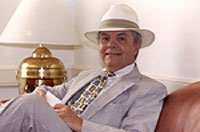 |
| James W. Ellsworth |
Some time ago, our Assistant Head of School for Advancement Mark LaFontaine asked me about the naming history of Seymour Hall.
School benefactor James W. Ellsworth (1849-1925) was the owner of the WRA campus starting in 1912, and eventually was able to reopen WRA as a boarding school (as it had been before 1903) in 1916. He was responsible for the corporation of trustees who operated the school and retained the naming rights for himself.
 |
| Seymour Hall |
Ellsworth ordered the demolition of Middle College (1827) in 1912 which stood on the location of the present Seymour Hall. The building was designed by Ellsworth's architect, J.W.C. Corbusier, who gave the campus a large, high style Georgian building that would nicely blend with the 19th century Brick Row structures like the Chapel and North Hall. The building was announced at the end of 1912, and ground was broken in 1913 (100 years ago this year), and finished in 1914. It was named for the Seymours, father and son, who had been favorite classics professors during the day of the old Western Reserve College. Nathan Perkins Seymour (1813-1891) had built the handsome house on Prospect Street in 1843 which is used as the school's guest house. Professor Seymour spent fifty years on our campus teaching first at the old college, then as a kind of adjunct to the Academy after the college moved to Cleveland.
 |
| Nathan P. Seymour House |
Nathan's son, Thomas Day Seymour (1848-1907) was born here in Hudson and was a year older than his boyhood friend, James W. Ellsworth, and probably attended the old Prep School with him in the 1860's. We know that they were close friends from a memoir written by Thomas Day Seymour's sister. He taught classics at the old Western Reserve College from 1872 to 1880 before moving on to Yale where he spent the rest of his life. He died at New Haven about the same time that his friend, James W. Ellsworth, returned to Hudson and determined on a course that would give him control of the WRA campus. There is no question that Ellsworth intended to honor the memory of the two Seymours with the construction of this academic building.
Ellsworth also was responsible for the restoring of all the historic buildings on our campus, and besides the erection of Seymour Hall, he also built the Bicknell Gym (1920), named for his close associate and WRA Board President Warren Bicknell, and Cutler Hall (1922), the large dining hall and dormitory at the corner of College and Prospect which Ellsworth wanted to be named for Carroll Cutler, President of the old Western Reserve College (1871-1886). Trustees decided to name this building in honor of the man who saved the school, James W. Ellsworth.
His insistence that these new buildings honor the great instructors of the 19th century was part of his way to instill a sense of tradition into his new venture.
Charles Seymour, the son of Thomas Day Seymour (1848-1907) became
President of Yale University in 1937 and visited our campus while he was
in office in order to see the house built by his grandfather and where
his father had been born and grew up. At the time the Seymour House was
owned by the Spangler family (1907-1948) not by the school itself. But
his visit to the campus is noted in the
Reserve Record. Charles
Seymour served as President of Yale until 1950.



